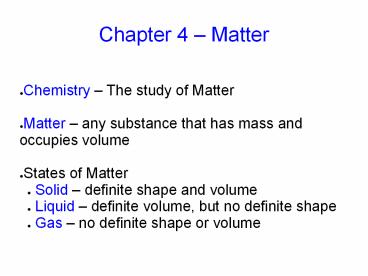Chapter 4 - PowerPoint PPT Presentation
Title:
Chapter 4
Description:
Chapter 4 Matter Chemistry The study of Matter Matter any substance that has mass and occupies volume States of Matter Solid definite shape and volume – PowerPoint PPT presentation
Number of Views:176
Avg rating:3.0/5.0
Title: Chapter 4
1
Chapter 4 Matter
- Chemistry The study of Matter
- Matter any substance that has mass and occupies
volume - States of Matter
- Solid definite shape and volume
- Liquid definite volume, but no definite shape
- Gas no definite shape or volume
2
(No Transcript)
3
- Physical Properties Can be observed without
affecting or changing the substance - color, odor, taste, size, state, boiling point,
melting point, density, hardness - Chemical Properties How a substance changes, or
resists changing, into another substance - oxidation, rusting, combustion, decomposition
- Intensive properties do not depend on the
amount of a substance - temperature, color, melting/boiling point,
density - Extensive properties do depend on the amount of
a substance - mass, volume, length, shape
4
(No Transcript)
5
(No Transcript)
6
- Physical changes No change in composition no
bonds are broken and/or formed - changes in size, shape, smoothness, state of
matter - Chemical changes Changes in chemical
composition bonds are broken and/or formed - oxidation, combustion, decomposition
7
(No Transcript)
8
(No Transcript)
9
(No Transcript)
10
(No Transcript)
11
- Matter can be divided into Pure Substances and
Mixtures - Pure substances Can't be broken down by
physical means into simpler substances - Elements Simplest stable form of matter can't
be broken down chemically. - Compounds Can be broken down by chemical means
into other compounds or elements.
12
(No Transcript)
13
(No Transcript)
14
(No Transcript)
15
- Mixtures Physical combinations of two or more
pure substances - Homogeneous mixtures Uniformly mixed on a
sub-microscopic scale one phase throughout - sugar water, air, metal alloys
- Heterogeneous mixtures Physical mixtures with
regions of different composition and/or phases
often different regions visible with the naked
eye - soup, dirt, blood, homogenized milk
16
(No Transcript)
17
(No Transcript)
18
(No Transcript)
19
(No Transcript)
20
- Elements
- Chemical symbols used to represent elements -
One or two letters, first is capitalized - Atom
- Smallest particle of an element that has the
properties of that element - Cannot be broken down by chemical means
- 10-10 m in diameter
- 10-21 -10-23 grams mass
- There are about 5 x 1021 atoms in a single drop
of water
21
(No Transcript)
22
- Molecules
- Usually only non-metals form molecules
- Two or more atoms tied together by molecular
(covalent) bonds - Have a fixed number of atoms in a set spatial
arrangement - H2O, CO2, CO, CH4, C6H13OH
23
- Molecules
- Binary composed of only two elements
- H2O, CO2, CO, CH4
- Diatomic composed of only two atoms
- H2, O2, Cl2, CO
- Homoatomic composed of only one element
- H2, O2, O3, S8
- Heteroatomic composed of different elements
- H2O, CO2, CO, CH4, C6H13OH
24
(No Transcript)
25
(No Transcript)
26
- Ionic Compounds
- Formed between metals and non-metals, and also
with polyatomic ions (electrically charged
molecules) - Have fixed ratios of positive to negative ions
- Overall electrically neutral
- Solid structure is a stacked array of ions
27
(No Transcript)
28
(No Transcript)
29
- Chemical Formulas
- Shows how many of each atom are in a compound
- For molecules, the formula shows the exact number
in a molecule, and sometimes give structural
information - For ionic compounds, the formula shows the lowest
whole number ratios of one ion to the others in
the compound - Parenthesis groups atoms, gives structural
information - Subscripts show how many of each element/group
are in the formula
30
H2CO3 2 H 1 C 3 O C2H3COOH 3 C 4 H 2
O Ca(OH)2 1 Ca 2 O 2 H Al2(SO4)3 2 Al
3 S 12 O
31
(No Transcript)































